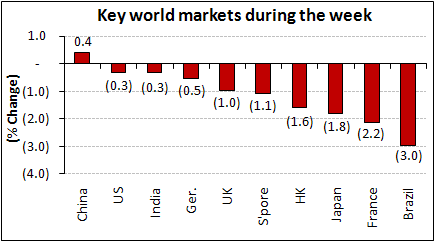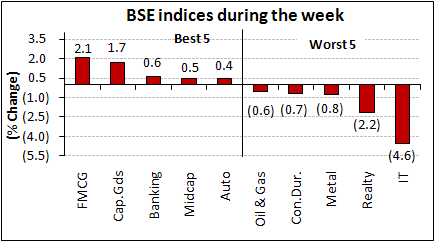India's Third Giant Leap
This Could be One of the Biggest Opportunities for Investors
- Home
- Todays Market
- Indian Stock Market News April 16, 2011
Markets pause after a hat-trick Sat, 16 Apr RoundUp
After registering positive gains for three consecutive weeks, the rally in world stock markets finally came to a halt. All global indices closed the week in the red with the exception of China. Brazil was the biggest loser (down 3.0% WoW) followed by France and Japan. Both France and Japan were down by 2.2% and 1.8% respectively. Nonetheless, US and the Indian stock market registered modest losses of 0.3% during the week.
US markets ended the week on a flat note (down 0.3% WoW) as concerns with respect to the corporate earnings dented investor sentiments. US stock markets overlooked the positive set of economic news reported during the week. Core-inflation figure in the US was below expectations while the consumer sentiment index was above expectations. However, earnings concerns overweighed the positive economic data. Even the Indian stock markets closed the week on relatively flat note (down 0.3% WoW) as disappointing results from IT bellwether Infosys and higher than expected inflation figure for the month of March dented investor sentiments.
Amongst the other markets, Hong Kong was down by 1.6% followed by Singapore (-1.1% WoW) and UK (-1.0% WoW). Even Germany was down by 0.5% during the week.
 |
| Source: Yahoo Finance |
Moving on to the performance of sectoral indices in India, FMCG and Capital Goods were the best performers during the week registering gains of 2.1% and 1.7% respectively. The IT sector was the worst performer as disappointing results from Infosys had a rub off effect on the entire IT pack. Even the real estate sector closed the week in the red as higher than expected inflation figure raised concerns over further rate tightening in the economy. Despite concerns over high inflation and rising interest rates, the banking index closed the week in the green which was a bit surprising.
Amongst the other indices the BSE-Metal index was down by 0.8% closely followed by BSE-Consumer Durable and BSE-Oil & Gas indices. Both the consumer durable and oil gas indices were down by 0.7%% and 0.6% respectively during the week. However, the BSE Midcap index and the BSE- Auto index closed the week on a relatively flat note.
 |
| Source: BSE |
Moving on to key sector news/economic developments, the overall industrial growth numbers for India were announced during the week. However, the numbers were not particularly encouraging. As per the latest data, the IIP growth slowed to 3.6% in February 2011, compared to 15.1% expansion in the year-ago period. This was due to the poor performance of manufacturing and mining sectors.
Despite accelerating inflation, food inflation fell to a year's low of 8.28% for the week ended April 2 as prices of certain essential items, like pulses and wheat, declined. This is the third consecutive week of decline in food inflation. The figure was 9.18% in the preceding week. This is a positive for the RBI especially since food inflation has been the main culprit in fuelling overall inflation. The RBI has already hiked rates 8 times in FY11 and is likely to continue doing so until overall inflation eases off and comes within the comfort levels of the central bank.
In important news from the cement sector, it is believed that the industry is likely to see a double-digit growth from the next fiscal. The current capacity in the industry is about 197 m tonnes (MT) and a further addition of 57 MT capacity is expected by 2014. It may be noted that cement market in India is one of the fastest growing in the world and second largest after China amongst emerging economies. Currently, the size of the domestic cement market stands at Rs 778 bn.
However, it is believed that the 57 MT additional capacity (as per Ernst & Young report) is unlikely to be absorbed domestically and utilization levels will remain at around 80%. From FY13, the demand will be more than supply and this trend is expected to continue in the medium to long-term. This can be attributed to two factors. One, low per capita intake of cement as compared to the global average and second the huge US$ 1 trillion infrastructure push by the government that will take place over the next five years.
Moving on to the key corporate news, IT major Infosys announced its results for the quarter and year ended March 2011. The company's sales grew by 2% QoQ during 4QFY11 and were aided by decent performance of its key segment. The company's main business of 'application development and maintenance' (38% of total sales) witnessed a growth of 2% QoQ mainly on account of a 5.3% QoQ growth in application development. The other key segment of 'consulting & package implementation' (26% of total sales) witnessed a lackluster performance with a 0.1% QoQ growth during the quarter. On an overall basis, the growth in sales was mainly due to the 3.7% QoQ increase in offshore billing rate during the quarter.
Operating margins witnessed a decline of 1.2% QoQ to 29% during the quarter mainly due to slightly higher cost of sales (as a percentage of sales). Sharp increase in other income led to a growth of 2% QoQ in net profits. The company added 34 new clients during the quarter taking the total number of active clients to 620. Infosys' attrition rate stood at 17.0% at the end of the current quarter, as compared to 17.5% at the end of the December 2010 quarter. Markets were not particularly enthused by the set of numbers reported by the company and thus the stock price corrected by approximately 10% in the last trading session.
In news from the FMCG sector, it is believed that Hindustan Unilever is struggling to maintain its market share in the shampoo segment. There are concerns that it is losing out to rivals like Proctor & Gamble and Dabur. As per Nielsen's January-February data, the company which is the market leader in shampoo segment, registered a decline in volumes thus reducing its market share to 47.3% (down by 1.3%) while P&G increased its market share to 17.7% (up 2.4%). Its other major competitor, Dabur, also performed relatively better securing a 6.7% market share (up 0.8%) in the same segment. The total Indian shampoo market is estimated to be worth Rs 30 bn currently. It may be noted that the decline in the market share is despite some volume growth in past few quarters.
Despite a decline in market share in the shampoo segment, the company has strong expansion plans over the next few years. It may be noted that the company is striving to double its top-line by 2015. Towards that end, the company is considering various strategies to gain the largest market share in the consumer goods space. Eyeing the opportunity that the summer season presents, HUL re-launched its Lifebuoy talcum powder brand in the prickly heat talc segment. The company has also gone in for brand extensions in Knorr (soup) and Kissan (jam and ketchup) brands that are leaders in their respective categories. In this manner, the company is aiming to fill in the white spaces in its product portfolio.
In news from the Oil & Gas sector, the government has passed an order asking RIL to first supply fuel to the priority fertilizer and power sectors. The reason for this is that the government is panicking in the light of the decline in output from the KG-D6 field. RIL produced 47.5 m cubic meters of gas per day in the week ended March 26th, 2011. This is down from 61.5 m cubic meters produced during the same period a year ago. As a result, RIL has gone ahead with pro-rata allocation of gas to all its customers including the fertilizer and power plants. The government wants to ensure that the priority sectors receive the fuel in the right quantities. Lower supply to fertilizer plants would mean that the plants would have to source the higher cost fuels, which would send the fertilizer subsidies soaring. Also, lesser fuel for power plants would mean lower generation. Now what this would mean is that the steel plants, refineries and petrochemical units that source gas from Reliance Industries' (RIL) KG-D6 fields may see their supplies get disrupted.
| Company | 8-Apr-11 | 15-Apr-11 | Change | 52-wk High/Low | |
| Top gainers during the week (BSE-A Group) | |||||
| Bhushan Steel | 463 | 518 | 11.8% | 545/254 | |
| Hero Honda | 1,686 | 1,831 | 8.6% | 2075/1379 | |
| Container Corp of India | 1,218 | 1,312 | 7.7% | 1500/1060 | |
| Jubilant Lifesciences | 182 | 196 | 7.6% | 413/149 | |
| Colgate | 844 | 893 | 5.9% | 996/685 | |
| Top losers during the week (BSE-A Group) | |||||
| India Infoline | 82 | 74 | -9.8% | 130/65 | |
| DLF Ltd | 271 | 245 | -9.4% | 397/215 | |
| Infosys | 3,245 | 2,989 | -7.9% | 3494/2565 | |
| Pantaloon | 300 | 277 | -7.7% | 531/233 | |
| PTC India Ltd | 96 | 89 | -7.5% | 145/81 | |
In order to attach greater importance to the development of telecom infrastructure, Telecom Regulatory Authority of India (TRAI) has extended certain tax benefits to the sector as a whole. In addition, telecom infrastructure companies also face number of problems with local civic authorities for setting up towers. TRAI has also recommended that a time line should be fixed in this regard so that the execution process does not face any hurdles. Recommendations are also made for introduction of Mobile Virtual Network Operator (MVNO) in the unified licensing regime. Further, it is also proposed that there would be no restrictions on the number of MVNOs attached to a particular mobile operator. We believe that the introduction of MVNOs will further fuel competition in the already crowded Indian telecom market. This is likely to impact the margins of the telecom companies.
The Associated Chambers of Commerce and Industry (Assocham) expects that the Indian Pharmaceutical industry would be worth US$ 20 bn (Rs 900 bn) by 2015. If the expectations of Assocham do materialize then India would be amongst world’s top 10 pharmaceutical markets. Also, the clinical trial business in India is expected to be worth US$ 1 bn (Rs 45 bn) by 2011. Such massive expansion in the pharmaceutical markets would increase the need of pharmacovigilance in the country. Pharmacovigilance is a program with a goal to provide safer medicines to the Indian population. However, the program has faced quite a few challenges up till now with population being one of them. Nonetheless, the ministry is planning to address the challenges by allocating a budget for such purposes.
For information on how to pick stocks that have the potential to deliver big returns, download our special report now!
Read the latest Market Commentary


Equitymaster requests your view! Post a comment on "Markets pause after a hat-trick". Click here!
Comments are moderated by Equitymaster, in accordance with the Terms of Use, and may not appear
on this article until they have been reviewed and deemed appropriate for posting.
In the meantime, you may want to share this article with your friends!